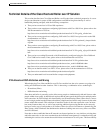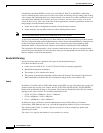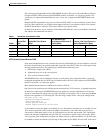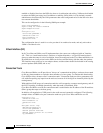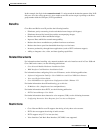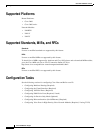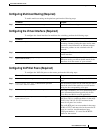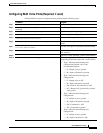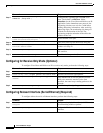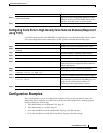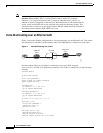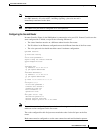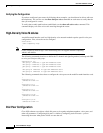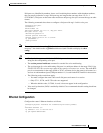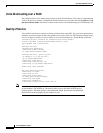
Cisco Hoot and Holler over IP
Configuration Tasks
15
Cisco IOS Release 12.1(5)T
Configuring E&M Voice Ports (Required, if used)
If using E&M voice ports, configure them by performing the following steps:
Command Purpose
Step 1
Router(config)# voice class permanent tag1
Defines voice class for transmit-receive mode.
Step 2
Router(config-class)# signal timing oos timeout
disabled
Disables signaling loss detection.
Step 3
Router(config-class)# signal keepalive number
Specifies keepalive signaling packet interval.
Step 4
Router(config-class)# exit
Returns to global configuration mode.
Step 5
Router(config)# voice-port
router-slot/voice-slot/VIC-port
Selects the voice port to configure.
Step 6
Router(config-voice-port)# voice-class permanent tag1
Uses voice class tag1 for the port that is allowed to
speak.
Step 7
Router(config-voice-port)# connection trunk
multicast-session-number
Ties the voice port to a multicast-session number.
Step 8
Router(config-voice-port)# music-threshold threshold
(Optional) Sets the music threshold to make VAD
less sensitive.
Step 9
Router(config-voice-port)# operation 4-wire
Specifies 4-wire operation. (2-wire is the default.)
Step 10
Router(config-voice-port)# type { 1 | 2 | 3 | 5 }
Selects the appropriate E&M interface type
(depending on the end connection—such as PBX):
• Type 1 indicates the following lead
configuration (default—this is the
recommended option):
–
E—Output, relay to ground
–
M—Input, referenced to ground
• Type 2 indicates the following lead
configuration:
–
E—Output, relay to SG
–
M—Input, referenced to ground
–
SB—Feed for M, connected to -48V
–
SG—Return for E, galvanically isolated
from ground
• Type 3 indicates the following lead
configuration:
–
E—Output, relay to ground
–
M—Input, referenced to ground
–
SB—Connected to -48V
–
SG—Connected to ground
• Type 5 indicates the following lead
configuration:
–
E—Output, relay to ground
–
M—Input, referenced to -48V



